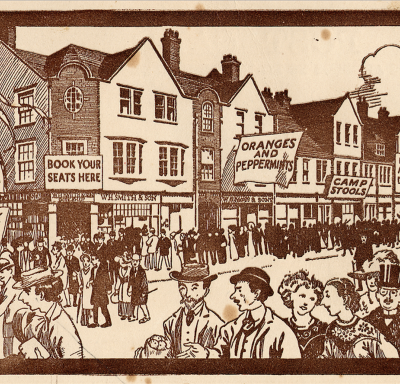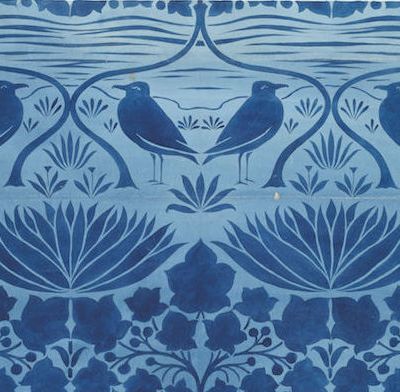Kearsney Court is a late Victorian house just outside Dover in east Kent. Designed in 1899 by Worsfold and Hayward for brewer Alfred Leney, it is a perfectly respectable essay in the Arts and Crafts manner – rough-cast walls, picturesque massing, and large bay windows. Its garden, though, is something else altogether. It cascades down a steep hill in a series of highly formal set pieces: semi-circular bastions, elaborate steps and decorative brick and tile balustrades. The garden is in fact far more formal than the house, its baroque complexity organised symmetrically along axial routes.
The gardens for Kearsney Court were laid out in 1901 by Thomas Mawson (1861–1933), the leading landscape architect of the early 20th century. Today they are in a partial state of decay awaiting a publicly funded refurbishment programme. Parts of the brick walls have fallen in, sections of balustrade are missing, and trees have been felled. Where there was once a small orchard there is a now a swathe of long grass interspersed with tree stumps. Hazard warnings and security fencing mark off sections where steps are missing or the path disappears into the undergrowth.
Today the gardens are split in two. The upper part still belongs to the residents of Kearsney Court (which was divided into flats in the 1950s), while the lower section is now a public park, named Russell Gardens after a mayor of Dover. This section also contains an ornamental canal, formed by damming the River Dour. At either end of this water feature, Mawson designed a picturesque bridge and, in the middle, a small boat house that sits perfectly on an axis with the steps that rise up through the rest of the gardens to the house. Mawson was a brilliant landscape designer, but he was a pretty good architect, too. The bridges are delightful structures, classical in inspiration with small paired Doric columns, but executed in Arts and Crafts materials of brick and timber.
It would be easy, especially in their current run-down state, to see the story of Kearsney Court and Russell Gardens as one of decline. Though not a grand house by any means, Kearsney proved too large to be owned by a single family and its gardens required a high level of upkeep. It was perhaps inevitable that the house would be divided up and the garden opened to the public – at least in part; this transition from private to public ownership was a familiar one for country houses in the post-war years.
The division of Kearsney Court and its gardens into public and private halves can be seen as symbolic, bridging two different stages of Mawson’s career. His garden design almost overwhelms the house, suggesting that he may have always regarded it as civic in scale and intent. The most formal part – the canal and its architectural structures – lies at the most accessible part of the site, highly visible from the road that runs along the southern boundary. Mawson’s later career as a designer of public parks reflects a level of ambition and civic scale that was present in earlier, private commissions such as Kearsney.
Mawson was born in 1861 in Lancashire, the son of a cotton-mill worker. He trained as a builder and then a gardener before setting up a nursery and gardening business with his brothers in Windermere. Private commissions as a landscape gardener followed, some for notable architects including Charles Voysey at Moor Crag and Baillie Scott at Blackwell, both on the banks of Lake Windermere. His success as a landscape designer led to him breaking away from the family business and opening his own highly successful office.
Thomas Mawson’s scheme for the gardens of the peace Palace in The Hague, depicted in a watercolour of 1908 by Robert Atkinson. Courtesy Carnegie Foundation Archive, the Peace Palace, The Hague

Mawson’s commercial aptitude and ambition marked him out from the enthusiastic amateurs that came before him. Unlike that of his near-contemporary Gertrude Jekyll – with whom he seems to have had a difficult relationship – Mawson’s work extended far beyond the hermetic idyll of the English country garden. He worked for industrialists including Lord Leverhulme, for whom he designed the gardens, including a 240m-long pergola, at Hill House in London, as well as parts of Port Sunlight. He designed perhaps his most notable public work for Andrew Carnegie: the gardens of the Peace Palace in The Hague in 1908. Here, Mawson’s repertoire of formal planting, Beaux-Arts planning, and the integration of architecture and landscape reached a peak. The work was affected by budget constraints but it is still a grand vision, and a public-spirited one.
There were schemes and city-scale projects in the United States and Canada, including landscape designs for Brooklandwood near Baltimore and Stanley Park in Vancouver, and Mawson’s work became associated with the City Beautiful movement. He spent much of his time abroad on lecture tours and promotional trips in ways that prefigured the global architecture practices of today. Mawson was a keen proselytiser of his own work too, publishing five editions of his hugely influential book The Art and Craft of Garden Making.
Even in his domestic designs, Mawson’s work employs grand forms, often hinting at something even more ambitious. At Kearsney, the use of circles combined with water suggests a much larger scale; reflections complete semi-circular forms and extend curves way beyond their physical limits. This combination of civic scale and formality avoids the romantic obsession with rustication and ruination of much English garden design. While employing historic forms, Mawson’s designs never appear nostalgic or elegiac in the way that Jekyll’s often do.
In Evelyn Waugh’s novel Brideshead Revisited (1945) the decline of the English stately home becomes synonymous with the decline of the country as a whole. The book’s narrator, Charles Ryder, finds himself at Brideshead during the Second World War, after it has been requisitioned by the British Army, and laments this passing from private to public use, seeing it as typifying the ‘age of the common man’.
Kearnsey Court can be seen as a lingering trace of a world that was soon to disappear. But it can also be seen as anticipating a world yet to come. Mawson’s work might best be regarded not as a lost Edwardian idyll, but as a harbinger of publicly funded post-war urbanism. Far from being diminished by this reading, his work appears optimistic and civic to its core.
From the February 2019 issue of Apollo. Preview and subscribe here.



